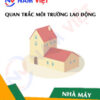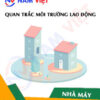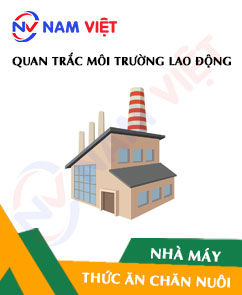Occupational environment monitoring of a brick manufacturing factory
99,000 ₫
Note: The above price is calculated for one sample, and the price may fluctuate depending on the area of the environment to be monitored and market movements. For more accurate pricing support, please refer to the price list or contact our consulting staff directly.
Monitoring the environment of a brick manufacturing factory is a session of collecting, analyzing, and evaluating factors at the workplace that may harm workers’ health.
Table of Contents
Toggle1. Overview of hollow brick manufacturing factory
a. What is a hollow brick manufacturing factory?
Factory manufacturing hollow bricks is a factory specializing in manufacturing hollow-shaped bricks, commonly used in construction projects to install water pipelines or gas pipelines. Hollow bricks are usually manufactured from clay and fired at high temperatures to create the necessary hardness and strength. Common types of hollow bricks used include large-diameter hollow bricks, square hollow bricks, rectangular hollow bricks, and U-shaped hollow bricks.

b. Manufacturing stages in a hollow brick manufacturing factory
The manufacturing stages in a hollow brick manufacturing factory include:
- Material preparation: Clay, sand, rubble, fly ash, and water are the basic materials for manufacturing hollow bricks.
- Mixing: The materials are mixed together using special mixers to create a uniform mixture.
- Molding: The clay mixture is pressed into molds cut to the exact dimensions of the hollow bricks.
- Firing: The molds are placed into kilns and fired at high temperatures from 900 to 1200 degrees Celsius for about 24 to 48 hours.
- Drying: After being fired, the hollow bricks are removed from the kiln and cooled down. Then, they are placed into dryers to remove excess moisture and increase the hardness of the bricks.
- Quality inspection: After manufacturing, hollow bricks are inspected to ensure technical standards are met.
- Packing and transportation: Hollow bricks are packed and transported to sales locations or directly to construction sites for use.

c. Types of machinery used in a hollow brick manufacturing factory
A hollow brick manufacturing factory uses various types of machinery to manufacture hollow brick products. Some common types of machinery used in the hollow brick manufacturing process include:
- Clay mixer: Used to mix clay, sand, rubble, fly ash, and water together to create a uniform mixture.
- Molding machine: Used to press the clay mixture into molds cut to the exact dimensions of hollow bricks.
- Kiln: Used to fire hollow bricks for 24 to 48 hours at temperatures from 900 to 1200 degrees Celsius to achieve high quality.
- Dryer: Used to remove excess moisture and increase the hardness of hollow bricks.
- Quality inspection machine: Used to check dimensions, durability, shape, and color of hollow bricks to ensure product quality.
- Packing and transportation machine: Used to pack and transport hollow brick products to sales locations or directly to construction sites for use.

d. What occupational diseases may workers in hollow brick manufacturing factories face?
Workers in hollow brick manufacturing factories may be exposed to chemicals such as cement, clay dust, fly ash, and other additives during the manufacturing process, posing health risks. Common occupational diseases may include:
- Lung diseases: Due to exposure to clay dust, fly ash, and airborne dust, workers may suffer from pneumonia, pulmonary tuberculosis, asthma, and pneumoconiosis.
- Skin diseases: Workers may experience skin irritation, hives, or dermatitis due to contact with cement.
- Kidney diseases: Workers may suffer kidney damage from exposure to toxic compounds in cement.
- Vision-related diseases: Due to exposure to dust, fly ash, and strong light during manufacturing, workers may experience red eyes, eye strain, dry eyes, or even vision loss.
- Ear-related diseases: Continuous exposure to noise in the factory may cause ear problems such as ear pain, hearing loss, and tinnitus.
- Musculoskeletal diseases: Manufacturing stages may require repetitive movements or carrying heavy loads, leading to musculoskeletal problems such as back pain, neck pain, and spinal degeneration.

e. Common types of hollow bricks in the market
Hollow bricks are cylindrical-shaped bricks mainly used as water or gas pipelines. In the market, some common types of hollow bricks include:
- Cement hollow bricks: Made of cement, sand, and water, commonly used in construction projects.
- Ceramic hollow bricks: Made from clay or clay mixed with minerals and glaze soil. This type of hollow brick has high durability and heat resistance, often used in water pipelines or gas pipelines in factories or power plants.
- Composite hollow bricks: Made from composite plastic or fiberglass and resin, lightweight, easy to transport and install, commonly used in air conditioning pipelines or industrial gas piping systems.

2. Overview of occupational environment monitoring services
a. What is occupational environment monitoring in a hollow brick manufacturing factory?
Occupational environment monitoring (or workplace environment measurement) in a hollow brick manufacturing factory is the activity of collecting, evaluating, and analyzing measurement indicators of occupational environment factors at the hollow brick manufacturing factory, in order to take timely measures, minimize environmental impacts on workers’ health, and prevent occupational diseases. Occupational environment monitoring is mandatory for hollow brick manufacturing factories.
Occupational environment monitoring plays the most important role in caring for, protecting, and improving workers’ health because the main resource of enterprises and the direct source of profits is the workforce. Workers frequently exposed to hazardous occupational factors exceeding permissible standards will have their health affected and may develop occupational diseases.
REGISTER FOR OCCUPATIONAL ENVIRONMENT MONITORING SERVICES
b. Occupational environment monitoring program of Nam Viet
The occupational environment monitoring program of Nam Viet is a program researched by monitoring engineers in the field of occupational safety and environmental protection. With the goal of ensuring workers’ health and safety, this program uses modern measurement methods to monitor air quality, water, and microclimate, physical, and dust factors in the workplace environment. This is a very important program in ensuring a safe working environment and protecting workers’ health.
In addition, the occupational environment monitoring program of Nam Viet also plays an important role in researching and developing new solutions to improve workplace environment quality. With the dedication and professionalism of the monitoring experts, the exclusive monitoring program of Nam Viet is becoming a breakthrough in occupational safety management and environmental protection in Vietnam.

c. Standardization in occupational environment measurement process
Standardization in the occupational environment measurement process of Nam Viet is a very important aspect in ensuring measurement results quality. To ensure accuracy and reliability of measurement results, this program applies recognized standards and standardized procedures from Ho Chi Minh City Department of Health. This ensures that collected data can be used with high reliability in occupational environment assessment and decision-making for workplace environment improvement to protect workers’ health.
These standardized procedures also ensure that measurement results are performed by a highly qualified and experienced monitoring specialist team, helping managers and experts trust results from An Toan Nam Viet and make accurate, valuable decisions in protecting workers’ health and the environment.
By applying standardization in occupational environment measurement processes, Nam Viet demonstrates its commitment to ensuring a safe working environment and protecting workers’ health, while also positively contributing to the development and improvement of occupational safety management and environmental protection quality in Vietnam.
d. Monitoring report results for hollow brick manufacturing factories
The occupational environment monitoring results are prepared according to Form No. 04 Annex III issued with Decree 44/2016/ND-CP and made into two copies: one sent to the labor facility that signed the occupational environment monitoring contract and one kept at the monitoring organization.
The storage time for occupational environment monitoring results follows the legal regulations, which is indefinite record storage.

e. Frequency of occupational environment monitoring according to legal regulations
According to Clause 2 of Article 18 of the Occupational Safety and Hygiene Law 84/2015/QH13, employers must organize occupational environment monitoring to evaluate harmful factors at least once a year.
f. Deadline for submitting occupational environment monitoring results according to legal regulations
The submission deadline is before December 31 every year. Enterprises belonging to manufacturing facilities are required to submit occupational environment monitoring results reports to the Department of Health at the locality where the manufacturing facility, business has its head office, and where employees are working.
When there are changes in technology processes, manufacturing processes, or when renovating or upgrading labor facilities that may generate new harmful factors affecting workers’ health, enterprises belonging to manufacturing facilities must update occupational hygiene records related to harmful factors requiring occupational environment monitoring.
g. Regulations on penalties for violations of occupational environment monitoring for employers
According to Article 27 of Decree No. 12/2022/ND-CP dated January 17, 2022, on administrative penalties in the field of labor, social insurance, and Vietnamese workers working abroad under contracts:
- Clause 2: A fine from 2,000,000 – 5,000,000 VND for employers failing to publicly announce to workers at occupational environment monitoring locations and at inspected, evaluated, and managed hazardous factor locations immediately after receiving occupational environment monitoring results and hazardous factor management results at the workplace.
- Clause 3: A fine from 20,000,000 – 40,000,000 VND for employers who do not carry out occupational environment monitoring to control harm to workers’ health as prescribed by law.
- Clause 4: A fine from 40,000,000 – 60,000,000 VND for employers who collude with occupational environment monitoring organizations to commit fraud in occupational environment monitoring activities but not to the extent of criminal liability.
3. Harmful environmental factors for workers in hollow brick manufacturing factories
Harmful environmental factors for workers in hollow brick manufacturing factories may include:
- Dust: The hollow brick manufacturing process often generates soil and mineral dust, especially when using machinery to grind soil and clay mixtures.
- Noise: Machinery and equipment in hollow brick manufacturing factories produce high noise levels, which can damage workers’ hearing if they are not properly protected.
- Temperature and humidity: The hollow brick manufacturing process often takes place in environments with high temperature and humidity, especially during the brick drying process. This may cause discomfort and fatigue for workers and can also lead to health problems.
- Chemicals: Some chemicals used in the hollow brick manufacturing process may be harmful to workers’ health. For example, cyanide and ammonia can harm the respiratory system and eyes.
- Other hazardous substances: In addition to the above factors, hollow brick manufacturing may also involve other hazardous substances such as lead, mercury, and asbestos. These substances can harm workers’ health if not used properly or without appropriate protective measures.
REGISTER FOR OCCUPATIONAL ENVIRONMENT MONITORING SERVICE
4. Measures to improve the working environment in hollow brick manufacturing factories
Measures to improve the working environment in hollow brick manufacturing factories include:
- Use of personal protective equipment: Workers must be fully equipped with personal protective equipment such as respirators, gloves, safety glasses, and safety shoes to protect their health.
- Ensure good ventilation: The use of ventilation systems, dust extraction, and air filtration helps reduce air pollution and dust in the factory.
- Noise reduction: Use noise control equipment to minimize noise in the factory, protect employees’ hearing, and reduce stress.
- Provide training and occupational safety guidance: Employees must be trained on occupational safety and the use of personal protective equipment, and be provided with practical guidance to ensure safety during work.
- Conduct regular equipment inspection and maintenance: Machinery and equipment in the factory must be regularly inspected and maintained to ensure they operate well and minimize accident risks.
- Enhance workplace hygiene: Tools, surfaces, and workspaces must be regularly cleaned to reduce the spread of bacteria and environment-related diseases.
- Regularly organize occupational environment monitoring in factories, collecting and analyzing harmful factors for workers, thereby adjusting and reducing hazards to prevent occupational diseases for them.
5. Benefits of periodic monitoring in hollow brick manufacturing factories
An Toan Nam Viet provides enterprises with excellent benefits when using occupational environment monitoring services in accordance with Decree 44/2016/ND-CP on the management and control of harmful factors in the working environment affecting workers.
- Enterprises can proactively control harmful factors at workshops or factories.
- Receive consulting and recommendations on measures to minimize harmful factors and improve the quality of the working environment.
- Indirectly protect human resources, the key factor in the enterprise’s development process.
- Minimize the impact of occupational diseases on human health, thereby reducing future medical treatment costs.
- Workers’ health is improved, leading to guaranteed and maintained product quality and output.
- Comply with labor safety laws, avoiding legal risks.
- Create credibility and professionalism in all aspects, thereby enhancing the enterprise’s brand value.
The occupational environment monitoring service of Nam Viet is the solution to minimize the impact of occupational diseases, contributing to creating a healthy and high-quality working environment.

6. National occupational environment monitoring center
Occupational environment monitoring center of Nam Viet is a professional unit in monitoring and measuring the quality of occupational environments throughout all provinces in Vietnam. With a team of experienced monitoring specialists, the center uses modern measuring equipment, ensuring accuracy and reliability.
In addition to providing monitoring services, the center also supports customers in planning, handling, and monitoring occupational environment issues. With the motto “customers are the center”, the center cares about customer satisfaction, meets all customer needs, and is committed to providing the best solutions for enterprises.
REGISTER FOR OCCUPATIONAL ENVIRONMENT MONITORING SERVICE
With investments in technology, equipment, and human resources, the monitoring center of Nam Viet has become one of the reputable units in the field of occupational environment monitoring in Ho Chi Minh City with the following objectives:
- We always value brand reputation and the quality of our service products.
- We provide customers with the best and most suitable solutions possible.
- Together with a team of experienced and specialized Masters and Engineers with the desire to protect the environment and benefit enterprises.
- With the Nam Viet monitoring team, your company will receive professional services from experts in the field of monitoring, along with the best cost advantages.
The occupational environment monitoring process at Nam Viet includes the following basic steps:
- Before conducting occupational environment monitoring, our company always ensures that machinery and equipment for occupational environment monitoring are adjusted and calibrated according to legal regulations.
- Strictly and fully implement the occupational environment monitoring process committed with the Department of Health.
- Honestly report occupational environment monitoring results to employers.
- In cases where occupational environment monitoring results do not ensure worker safety, Nam Viet company will support by providing solutions, and the labor facility will implement as follows:
- Implement measures to improve working conditions to minimize harmful factor impacts and prevent occupational diseases.
- Organize health examinations to detect early occupational diseases and job-related diseases for workers in unsafe environments.
- Provide material allowances for workers in accordance with labor law regulations.

7. Quotation for occupational environment monitoring
To help enterprises carry out occupational environment monitoring professionally and effectively, Nam Viet provides customers with a price quotation for occupational environment monitoring services with high quality and reasonable costs.
- Our monitoring quotation provides detailed information about the pricing of the monitoring services we offer, including costs related to transportation, measurement, analysis, and reporting results. Customers can be fully assured of the accuracy and reliability of the monitoring reports we provide.
- We are committed to always offering the most competitive and reasonable prices in the market, and we are always ready to provide professional and quick consultation to answer all questions about monitoring services.
- With the monitoring quotation of Nam Viet, customers can easily choose service packages that suit their needs. We are committed to delivering the highest satisfaction with professional service quality.
No comments yet












Review Occupational environment monitoring of a brick manufacturing factory
There are no reviews yet.